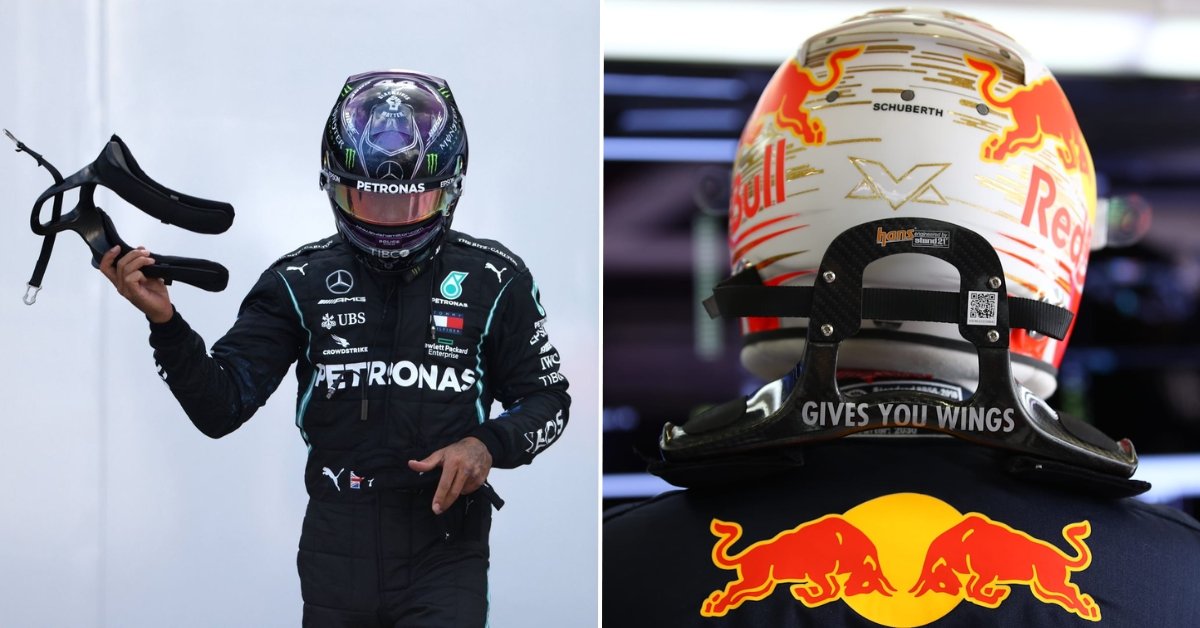Post-qualifying or post-race, you may see F1 drivers walking around with padding attached to their helmets that sit around their neck and shoulders. Whilst this undoubtedly looks very comfortable, its purpose extends much deeper than just being a cushion for the drivers whilst they race around demanding circuits at 200mph.
The Head and Neck Support, or HANS for short, is a customised, lightweight carbon fibre device that is moulded to the neck and shoulders of drivers. Its design is to minimise the effects of extreme G-forces acting on the drivers and reduce the risks of extreme head and neck injuries.
How does the HANS device work in F1?
The HANS device attaches to the base of a driver’s helmet, with two arms extending in a U-shape past the collar bones and is secured under the seatbelt in the car.
The device aims to stabilise the head and neck of the drivers whilst they experience high G-forces, with the arms of the device acting as shock absorbers that redistributes the G-force from the neck to the shoulders and chest of the drivers.
The HANS device is believed to be able to reduce neck tension in the event of an accident by over 70% and limits the amount of head and neck movement during a crash, which significantly reduces the risk of head and neck-related injuries.
When did F1 decide to make the HANS device mandatory?
The HANS device was a concept created by Dr Richard Hubbard following the death of one of his brother-in-law’s friends whilst he was racing in American Le Mans due to a head injury. However, it wasn’t until 1994, the year that Ayrton Senna and Roland Ratzenberger both lost their lives, that the FIA gained interest and made it part of their targeted focus for safety in F1.
A key turning point was following the death of Dale Earnhardt, during the 2001 Daytona 500, who lost his life due to fatal head injuries. An early development of the HANS device was made available to him during this event. However, he refused to use it as he believed it would restrict his visibility in the cockpit.
After the loss of a huge motorsport figure, F1 didn’t hesitate to make the HANS device mandatory for all drivers and introduced it into the sport in 2003.
How many lives has the HANS device saved?
As with all new introductions to the sport, the drivers – at first – were hesitant to use the HANS device. However, Fernando Alonso’s 60G crash at the 2003 Brazilian Grand Prix soon saw the importance of such safety features be reinforced.
Speaking after the incident, the young Spaniard said, “For me, the system isn’t at all uncomfortable in the car, and it was definitely an advantage at that moment. With that kind of crash, you usually suffer from neck pains afterwards, and I have had no problems at all. I think that the HANS device helped in that, and did a very good job in that particular crash.”
To say the 2003 #BrazilGP ended dramatically would be an understatement 💥
Webber had a huge crash, and was followed by Alonso seconds later 😱
The resulting carnage blocked the track, ending the race early 🚩 #F1 pic.twitter.com/1i9I6CRY5V
— Formula 1 (@F1) November 7, 2018
More recently, the HANS device was one of four crucial safety features that assisted in saving Romain Grosjean’s life after his fireball accident at the 2020 Bahrain Grand Prix. Grosjean was sent into the metal barriers after decelerating to avoid hitting the runners in front of him and clipping Daniil Kvyat in the process.
Grosjean’s car went up in flames as he made contact with the barriers, but managed to escape the fire, with burns on his hands and a sprained ankle. The HANS device stabilised his head and neck in this 53G crash – an accident that 20 years prior would have killed the Frenchman.
These are just two examples of the HANS device playing a crucial part in motorsport safety, but the reality is that it has saved dozens of lives since its introduction in the early 2000s.
The importance of the HANS device has now been demonstrated globally and extends past the realms of Formula One, with it now being a mandatory feature for drivers in both amateur and professional motorsport series, such as NASCAR, British Touring Car and World Rally Championship.












